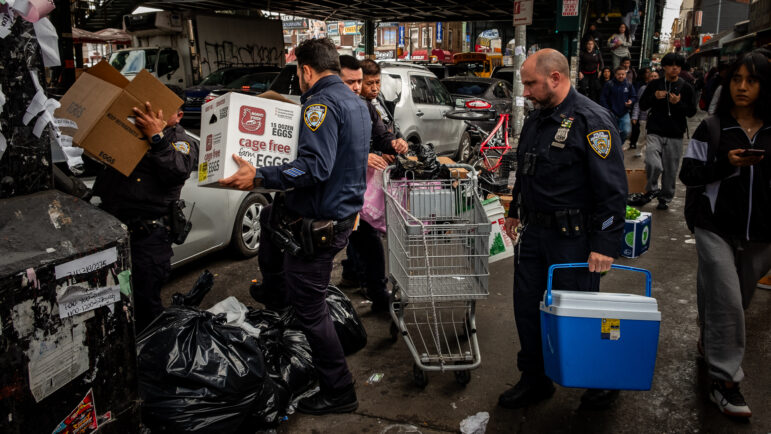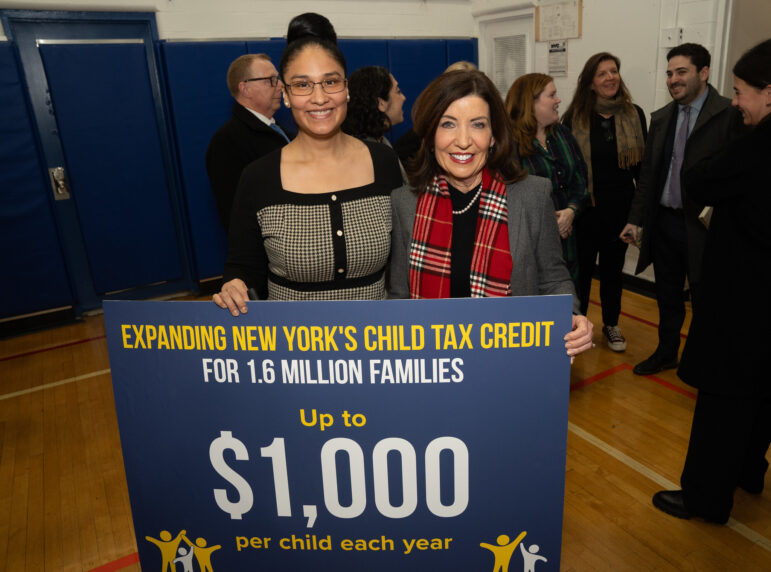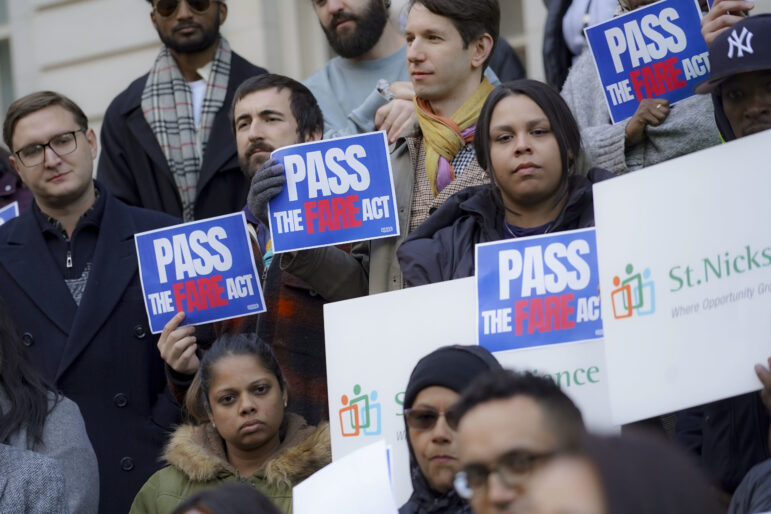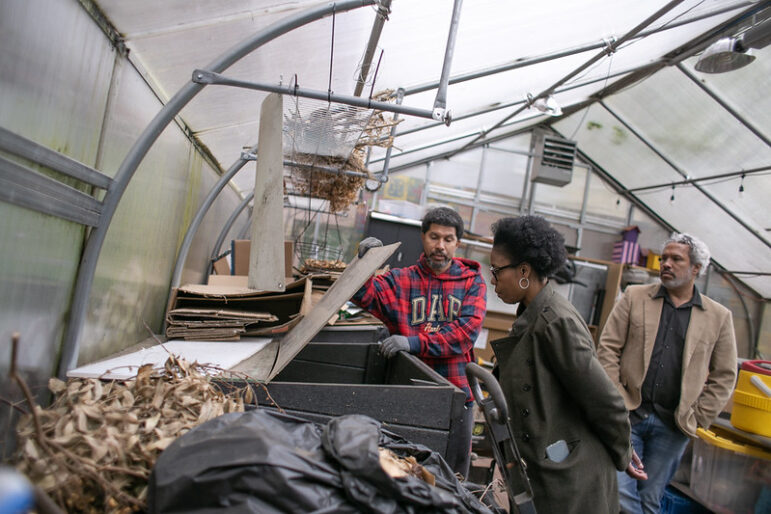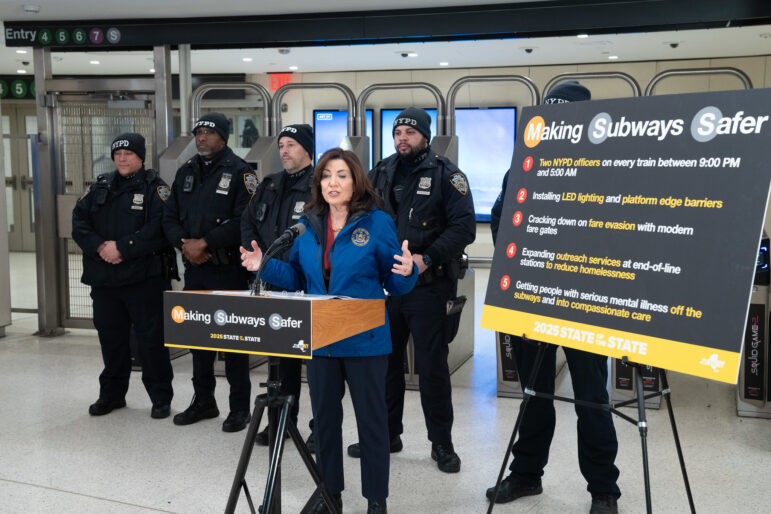Sandra Hernandez uses her Mott Haven, South Bronx neighborhood as an exhibit of the power of community organizing. The first display is right next door to her apartment.
Four years ago, when the city was looking to find a new owner for six buildings on her block, she pulled together a cadre of residents to make loud demands on the doorstep of the city housing agency. After some negotiation, they were able to get what they wanted-a landlord that gives back to the community. He has come to community meetings, paid for a band and food for a recent block party, and even provided Hernandez with a free basement office for a community center.
A quick walk down 139th Street yields more evidence of organizing’s might. At an imposing, 10-story brick apartment building in the middle of the block, Hernandez helped organize a tenant association that convinced the federal Department of Housing and Urban Development to repossess the 114-unit building. Several neatly fenced empty lots down the street are the products of a march on the city Sanitation Department.
In front of PS 40, a school maintenance man complains to Hernandez that the fencing crew missed a garbage-strewn lot next door. He says the local community board is ignoring his calls. “No, no, that’s not going to work,” Hernandez tells him emphatically. “What we need to do is go down there with some people. Then this will get cleaned up.”
But Hernandez isn’t in all this alone. She’s a community leader for the Bronx chapter of the Association of Community Organizations for Reform Now, better known as ACORN. During its 15 years in New York City, ACORN has helped squatters claim derelict city-owned property, forced bankers to invest in low-income communities, and organized a war against the city’s workfare program.
It’s also developed a reputation for no-holds-barred tactics-getting results through adversarial campaigns against bankers, politicians and bureaucrats using confrontation and concession rather than consensus. ACORN, unlike most social service nonprofits, scorns charity. Their goal is to help poor people seize power.
So it’s a little surprising to hear that, for the last two years, Hernandez’s neighbors have looked to ACORN for drug rehab, domestic violence counseling and job training.
The tactical change comes courtesy of the Edna McConnell Clark Foundation and its $15 million Neighborhood Partners Initiative. The foundation tapped ACORN and some of the biggest South Bronx and Central Harlem community development and social service groups for a seven-year experiment in organizational cross-dressing. So ACORN is learning about social services, and the Highbridge Community Life Center, Mid-Bronx Senior Citizens Council, Rheedlan Centers for Children and Families, and Abyssinian Development Corporation are taking the plunge into organizing.
The program is ambitious, trying to assemble a range of organizations, and trying to solve a wide range of social ills in these neighborhoods simultaneously. “One of the different approaches that we took is that we decided to work through a diverse array of lead organizations, not just CDCs, not just service providers,” explains Nancy Roob, the project’s former director at Edna McConnell Clark. “We were interested–as an explicit part of the design–in understanding the experiences of different kinds of organizations.”
But this arranged marriage between traditional neighborhood-building and confrontational organizing hasn’t always been easy, and the experiment is still underway. ACORN has struggled at times to incorporate the project, both ideologically and practically, into its work. And the other groups are finding that organizing a low-income community isn’t as easy as they might have thought.
_______
The Neighborhood Partners Initiative is part of a relatively new field called comprehensive community initiatives. CCIs have become a darling of the foundations during the last 10 years, with the Annie E. Casey, Ford, Rockefeller and Enterprise Foundations spending tens of millions of dollars on them around the country. They usually have a geographical focus, pouring money into an array of programs in one neighborhood. Unlike many foundation-driven projects, they last five years or more. And they attempt to go to greater lengths to involve the local population in decision-making along the way.
Call it want you want–community building, community development, even empowerment–the idea is that to transform a neighborhood, neighborhood people need to be in charge. “Community development is always a goal. Whether or not [CCIs] achieve this is another story,” says Patricia Jenny, project director at New York Community Trust, a local foundation that focuses on community projects. “Part of it is knowing if the idea of the project is to have people sitting on boards…or to build the capacity of individuals to have control over their personal lives.”
Yet, from their inception, CCIs have been almost exclusively steered by community development corporations and social service organizations. And according to many critics, these professional nonprofits don’t truly give residents the ability to hold their own against government, businesses and other private interests. “You’re talking about fundamental change in the amount of resources going to an area and in power relations,” says Rebecca Stone, research associate at Chapin Hall, which helps foundations evaluate CCIs. “You need community organizing to effect that power shift.”
But the foundation world tends to be cautious, preferring to fund consensus-building projects. In-your-face organizing can scare off potential business and government partners. “Consensus organizing involves all kinds of stakeholders, [including] bankers and businesses,” explains Larry Parachini, a consultant for grassroots organizers. “Foundations see community organizing as a potential problem for that kind of collaboration.”
So Edna McConnell Clark was bucking the trend when they asked ACORN to get involved in their initiative. The foundation was impressed with ACORN’s work, and saw that in the Bronx they’d been able to get results working with the city housing agency. “You have to have resident engagement. You can’t improve a neighborhood over the long term without it,” says Deborah Thompson, who currently directs the initiative. “You have to have an organizing strategy to do community building.”
The decision cut both ways. The four community development groups, with little experience in organizing, were expected to partner with small neighborhood grouplets like tenant and block associations, and if necessary create new organizations. The foundation even paid for consultants and workshops to teach the nonprofits how to rally a neighborhood.
Then, other than requiring that the groups set specific, concrete goals, Edna McConnell Clark tried to stay out of the picture. The foundation didn’t set an agenda–the communities had to do that.
_______
Even though the foundation promised a grassroots approach, ACORN was leery. Staffers were intensely worried that the project–and the big budget–could undercut ACORN’s basic organizing mandate.
Uncommon among nonprofits, ACORN is structured more like a union than a charity. In addition to getting grants from foundations, churches and government, 35 to 40 percent of the Bronx ACORN chapter’s budget comes from internal fundraising and five-dollar-a-month memberships. Members are considered to be owners of their local chapter: They set the agenda and decide what issues to focus on.
But when the Edna McConnell Clark money came through, some ACORN staff became worried that the group was selling itself out. “Many organizations started out as organizers doing campaigns. Then they metamorphosed into social services groups and community development corporations,” explains Bertha Lewis, lead organizer in the Brooklyn ACORN. “With the foundation funding, they were beginning to lose their identity.” Even Helene O’Brien, the former Bronx lead organizer who had wooed the foundation to begin with, was a little a nervous.
A lot of the worry was over the size of the pot: ACORN gets about $200,000 a year from the foundation. About a quarter goes for administrative overhead, and the rest is salaries–for a job developer, a housing director and a social services organizer. “Staff organizers were concerned about what the foundation agenda was, versus the neighborhood agenda,” says Eric Thompson, current lead organizer in the Bronx. “A foundation puts all of that money into a neighborhood, you wonder what’s on their agenda.”
And some of it was simply ideological. New York ACORN has certainly done more than organize: They run two public high schools, a loan counseling program and the ACORN Housing Company, which has renovated more than 500 units of housing. But for some ACORN staffers, providing social services means labeling community residents as sick and needy people, rather than people who can help themselves.
More specifically, despite the group’s long history in the community, some Mott Haven residents were afraid they would become meddlesome. “Members felt if we did social service, we’d turn on them, because that’s what social workers do,” says O’Brien. “Members were scared we’d take their children away.”
O’Brien says her worst fears have turned out to be unfounded, but she has had to make other allowances. In Mott Haven, ACORN members can attend local meetings whether or not they’ve paid their dues–in a sense, Edna McConnell Clark has already paid their way. But O’Brien worries about what will happen five years from now when the funding ends. So she still asks residents to pay something at meetings-if they don’t have five dollars, she’ll take their best offer. “I even once accepted $1.10 in dimes,” she says.
So staff and members sat down with Roob and others at Edna McConnell Clark to make sure that the foundation wouldn’t intrude. ACORN also created a neighborhood advisory board to determine which issues they should tackle. Projects have included a Hiring Hall, which keeps resumes of Mott Haven residents on file for potential employers, and a taskforce to work with the local precinct on police brutality and crime.
The Hiring Hall project actually grew organically out of ACORN’s organizing efforts against big New York City corporations like Viacom, Time Warner, ABC/Disney and Marriott. As a result of ACORN’s protests, the companies have promised to provide more jobs for residents in low-income communities. The Hiring Hall helps the companies keep this pledge-and keeps job creation tied to organizing. “If people just passed through and we never see them again working on any other issues, we will seriously question whether the Hiring Hall makes sense,” says O’Brien.
But for most of ACORN’s other programs, the organization has avoided feeling like they’ve sold out by partnering with established, independent social service providers for drug rehab programs, job training and English as a Second Language courses. They also cooperate with a women’s support group that uses yoga, meditation and discussions to help abused women. And when community members come into the office for referrals for classes or services, they get an earful from ACORN organizers about other issues and campaigns.
But partnering up hasn’t been a smooth road. The group wound up in a dispute with St. Peter’s, a local Lutheran church where Hernandez is a deacon. When O’Brien first sought Edna McConnell Clark funding, she sat down with church members, among other local leaders, to talk over community concerns. As a result, when the money came through, the church leaders felt entitled to some of the funding for their after-school program, food pantry and soup kitchen.
“When the money came in, everybody went crazy,” Hernandez says. Tempers flared when the church demanded that ACORN hire only local residents to staff their projects, and the group refused.
ACORN maintained that the Edna McConnell Clark money was intended less as direct support for groups, and more as a resource for ACORN to use its techniques to help others. Eventually, the group ended up giving the church a $15,000 grant it had received to run a summer program. It also put St. Peter’s on its list of partners for money from the Fund for the City of New York.
O’Brien deftly puts the fight in the context of building community pride and an activist attitude. “It’s good that the group felt entitled and secure enough to come up to ACORN and say, ‘That’s ours,'” she says.
_______
While ACORN struggled with the details of social service delivery, the other four groups in the project have faced the opposite identity crisis. These groups, with a history of building housing or providing services, were now being asked to become organizers–to deal with grievances, power dynamics and personalities.
For 20 years, the South Bronx’s Highbridge Community Life Center has been offering services: an after-school program, GED courses and English as a Second Language. In order to learn organizing, they hired ACORN’s O’Brien to teach them how.
Now, community residents are called members, not clients. And Lori Savron, the program’s project director at Highbridge, says the group has made more significant changes, like becoming more open to activists tactics and strategies. This year, the group tried its hand at an ACORN-style action, protesting at a South Bronx post office over inefficient mail delivery to the Highbridge community. Postal officials promised to change mail routes in the neighborhood, and residents are now working for a larger, more permanent solution.
Savron was hired by Highbridge to organize, but she finds that her work is physically and even emotionally cut off from the rest of the organization, making it difficult at times to integrate her project with the group’s classes and services. Her counterparts at the Abyssinian Development Corporation report a similar experience. “We didn’t feel like we fit in,” Savron says.
And outside the office, the organization’s social-services image can be confusing, says Savron. The community has had trouble adjusting to this new focus of the organization, traditionally a problem-solver. “People recognize Highbridge as a social service group. That means they expect that you come and we help you,” Savron says. “We had to keep saying, ‘We’re not going to fix your wall for you. We’ll help you get it done yourself.'”
Although Abyssinian has developed housing in Central Harlem for years, its organizers found that local residents had a hard time believing the group would do them much good. Many other agencies had come into the neighborhood, making promises they’d failed to keep. “There was distrust among the residents,” explains Pat Simmons, the project director of Abyssinian Development Corporation’s program. “These blocks had been promised a lot. Other groups came in and made promises and went away.” Abyssinian’s answer was to set up a neighborhood advisory group that grapples with issues like economic development, youth services and senior housing.
_______
As far as ACORN’s Bertha Lewis is concerned, the Bronx group’s experiment with CCIs and social service work hasn’t set a bad precedent, notwithstanding a few setbacks. Lewis has been watching the program closely, to see if she might be able to replicate it in Brooklyn. In fact, the biggest problem she sees is getting foundation interest–and money–to follow her to Kings County. “I don’t know if foundations would try the same program in Brooklyn,” she says. “The South Bronx is very sexy. East New York and Bed-Stuy have had their day.”
If O’Brien has her way, however, the idea might go a lot further than Brooklyn. O’Brien just started a new job, as national director of all of ACORN’s lead organizers, and she’s been floating the social services concept around.
And Edna McConnell Clark wants the idea to catch on with other funders. “We hope foundations learn lots of lessons: the implications of working in a small area…and the priorities of organizing,” Thompson says.
With the push for CCIs nearly a decade old, some observers say the time has come for community organizing. This work must begin soon, they say, or the comprehensive experiment won’t be worth the time and money. “Foundations have been hearing from several groups, ‘How do you expect us to do this work without organizing? How can we organize without it being part of the funding?'” says Chapin Hall’s Stone. “It’s time to fish or cut bait.”


